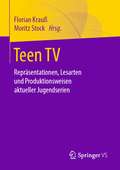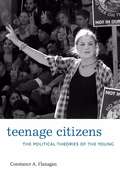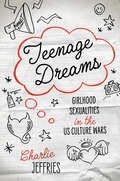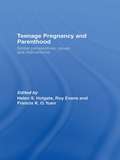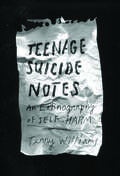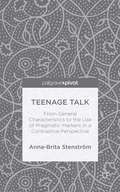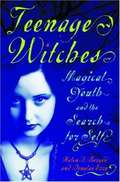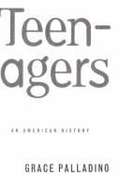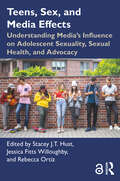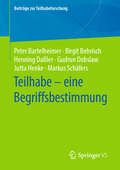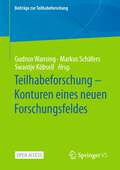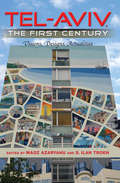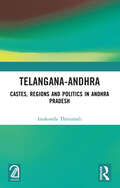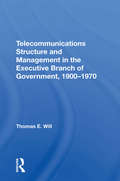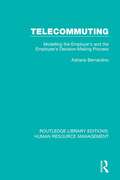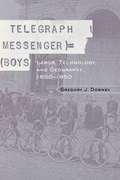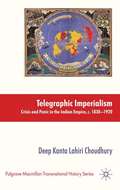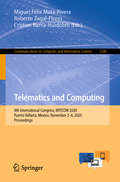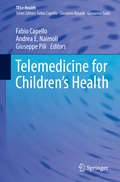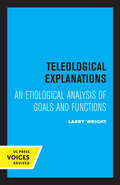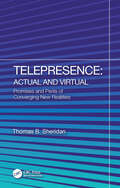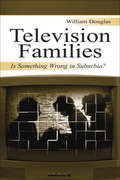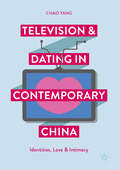- Table View
- List View
Teen TV: Repräsentationen, Lesarten und Produktionsweisen aktueller Jugendserien
by Florian Krauß Moritz StockDas Teen TV boomt. Aktuelle Jugendserien auf Streaming-Plattformen sind dafür ein klares Indiz, haben in der deutschsprachigen Medienwissenschaft bislang aber kaum Beachtung gefunden. Dieser Sammelband führt grundlegend in das serielle Teen TV ein und nimmt zentrale Fallbeispiele in den Blick, von 13 Reasons Why bis zu DRUCK, der deutschen Adaption des norwegischen Transmedia-Jugenddramas SKAM. Neben den Inhalten und der Ästhetik der seriellen Jugendnarrationen geht es um ihre Rezeption und um Produktionskontexte.
Teenage Citizens
by Constance A. FlanaganMost teenagers are too young to vote and are off the radar of political scientists. Teenage Citizens looks beyond the electoral game to consider the question of how this overlooked segment of our citizenry understands political topics. Bridging psychology and political science, Constance Flanagan argues that civic identities form during adolescence and are rooted in teens’ everyday lives-in their experiences as members of schools and community-based organizations and in their exercise of voice, collective action, and responsibility in those settings. This is the phase of life when political ideas are born. Through voices from a wide range of social classes and ethnic backgrounds in the United States and five other countries, we learn how teenagers form ideas about democracy, inequality, laws, ethnic identity, the social contract, and the ties that bind members of a polity together. Flanagan’s twenty-five years of research show how teens’ personal and family values accord with their political views. When their families emphasize social responsibility-for people in need and for the common good-and perform service to the community, teens’ ideas about democracy and the social contract highlight principles of tolerance, social inclusion, and equality. When families discount social responsibility relative to other values, teens’ ideas about democracy focus on their rights as individuals. At a time when opportunities for youth are shrinking, Constance Flanagan helps us understand how young people come to envisage the world of politics and civic engagement, and how their own political identities take form.
Teenage Dreams: Girlhood Sexualities in the U.S. Culture Wars
by Charlie JeffriesUtilizing a breadth of archival sources from activists, artists, and policymakers, Teenage Dreams examines the race- and class-inflected battles over adolescent women’s sexual and reproductive lives in the late twentieth and early twenty-first century United States. Charlie Jeffries finds that most adults in this period hesitated to advocate for adolescent sexual and reproductive rights, revealing a new culture war altogether--one between adults of various political stripes in the cultural mainstream who prioritized the desire to delay girlhood sexual experience at all costs, and adults who remained culturally underground in their support for teenagers’ access to frank sexual information, and who would dare to advocate for this in public. The book tells the story of how the latter group of adults fought alongside teenagers themselves, who constituted a large and increasingly visible part of this activism. The history of the debates over teenage sexual behavior reveals unexpected alliances in American political battles, and sheds new light on the resurgence of the right in the US in recent years.
Teenage Pregnancy and Parenthood: Global Perspectives, Issues and Interventions
by Helen S. Holgate Roy Evans Francis K. O. YuenThe debate of teenage pregnancy and parenthood continues to be a topical media and political issue, and a contested policy area. Covering the controversial issues, this book contributes to the debate, filling the gap in the current market. The strong chapter selection looks at areas such as: education social policy and welfare reforms in the UK and US issues for young fathers child sex abuse girls with emotional and behavioural difficulties. This is invaluable reading for those working on government strategies to reduce teen pregnancies and those working in sex education and youth care.
Teenage Suicide Notes: An Ethnography of Self-Harm
by Terry Williams"Picturing myself dying in a way I choose myself seems so comforting, healing and heroic. I’d look at my wrists, watch the blood seeping, and be a spectator in my last act of self-determination. By having lost all my self-respect it seems like the last pride I own, determining the time I die.”-Kyra V., seventeen <P><P>Reading the confessions of a teenager contemplating suicide may be uncomfortable, but we must do so to understand why self-harm has become an epidemic, especially in the United States. What drives teenagers to self-harm? What makes death so attractive, so liberating, and so inevitable for so many? In Teenage Suicide Notes, the sociologist Terry Williams pours over the writings of a diverse group of troubled youths to better grasp the motivations behind teenage suicide and to humanize those at risk of taking their own lives. <P><P>Williams evaluates young people in rural and urban contexts and across race, class, gender, and sexual orientation. His approach, which combines sensitive portrayals with objective sociological analysis, adds a clarifying dimension to the fickle and often frustrating behavior of adolescents. Williams reads between the lines of his subjects’ seemingly straightforward reflections on alienation, agency, euphoria, and loss, and investigates how this cocktail of emotions can create an overwhelming and impossible desperation. Rather than treat these notes as exceptional examples of self-expression, Williams situates them at the center of teenage life, linking them to incidents of abuse, violence, depression, anxiety, religion, peer pressure, sexual identity, and family dynamics. He captures the currents that turn self-destruction into an act of self-determination, which also allows him to propose more effective solutions to resolving the suicide crisis.
Teenage Suicide Notes: An Ethnography of Self-Harm (The Cosmopolitan Life)
by Terry Williams"Picturing myself dying in a way I choose myself seems so comforting, healing and heroic. I'd look at my wrists, watch the blood seeping, and be a spectator in my last act of self-determination. By having lost all my self-respect it seems like the last pride I own, determining the time I die."-Kyra V., seventeenReading the confessions of a teenager contemplating suicide is uncomfortable, but we must do so to understand why self-harm has become epidemic, especially in the United States. What drives teenagers to self-harm? What makes death so attractive, so liberating, and so inevitable for so many? In Teenage Suicide Notes, sociologist Terry Williams pores over the writings of a diverse group of troubled youths to better grasp the motivations behind teenage suicide and to humanize those at risk of taking their own lives.Williams evaluates young people in rural and urban contexts and across lines of race, class, gender, and sexual orientation. His approach, which combines sensitive portrayals with sociological analysis, adds a clarifying dimension to the fickle and often frustrating behavior of adolescents. Williams reads between the lines of his subjects' seemingly straightforward reflections on alienation, agency, euphoria, and loss, and investigates how this cocktail of emotions can lead to suicide—or not. Rather than treating these notes as exceptional examples of self-expression, Williams situates them at the center of teenage life, linking them to abuse, violence, depression, anxiety, religion, peer pressure, sexual identity, and family dynamics. He captures the currents that turn self-destruction into an act of self-determination and proposes more effective solutions to resolving the suicide crisis.
Teenage Talk: From General Characteristics to the Use of Pragmatic Markers in a Contrastive Perspective
by Anna-Brita StenströmThis in-depth study of the use of pragmatic markers by Spanish and English teenagers offers insight into the currently under-investigated area of teenage talk through the analysis of the Corpus Oral de Lenguaje Adolescente de Madrid and The Bergen Corpus of London Teenage Talk.
Teenage Witches: Magical Youth and the Search for the Self
by Helen A. Berger Douglas EzzyA popular new image of Witches has arisen in recent years, due largely to movies like The Craft, Practical Magic, and Simply Irresistible and television shows such as Buffy the Vampire Slayer, Sabrina the Teenage Witch, and Charmed. Here, young sexy Witches use magic and Witchcraft to gain control over their lives and fight evil. Then there is the depiction in the Harry Potter books: Witchcraft is a gift that unenlightened Muggles (everyday people) lack. In both types of portrayals, being a Witch is akin to being a superhero. At the other end of the spectrum, wary adults assume that Witches engage in evil practices that are misguided at best and dangerous at worst. Yet, as Helen A. Berger and Douglas Ezzy show in this in-depth look into the lives of teenage Witches, the reality of their practices, beliefs, values, and motivations is very different from the sensational depictions we see in popular culture. Drawing on extensive research across three countries--the United States, England, and Australia--and interviews with young people from diverse backgrounds, what they find are highly spiritual and self-reflective young men and women attempting to make sense of a postmodern world via a religion that celebrates the earth and emphasizes self-development. The authors trace the development of Neo-Paganism (an umbrella term used to distinguish earth-based religions from the pagan religions of ancient cultures) from its start in England during the 1940s, through its growing popularity in the decades that followed, up through its contemporary presence on the Internet. Though dispersed and disorganized, Neo-Pagan communities, virtual and real, are shown to be an important part of religious identity particularly for those seeking affirmation during the difficult years between childhood and adulthood.
Teenagers: An American History
by Grace PalladinoRanges widely across American culture of the middle twentieth century to depict the shifting characterizations of teens from invisible young adults to young soldiers in training, to bobby soxers and zoot suiters, to rock 'n' rollers and juvenile delinquents, from hippies to savvy consumers. In this book, Grace Palladino examines everything from Andy Hardy and Elvis Presley to Seventeen magazine and MTV.
Teens, Sex, and Media Effects: Understanding Media’s Influence on Adolescent Sexuality, Sexual Health, and Advocacy
by Stacey J.T. Hust Jessica Fitts Willoughby Rebecca OrtizWith teens having more control and choice over their media consumption than ever before, this book highlights how the current media landscape impacts adolescent sexuality in the areas of identity development, romantic and sexual relationships, sexual health, and advocacy and education.Recognizing that teens are often media multitaskers and media effects do not occur in isolation by platform, the book includes examinations of a wide variety of media types and content to provide a more comprehensive look at the media landscape and its impact on teen sexuality. While the text includes empirical, data-driven chapters that are authored by experts in the field, it also prioritizes the diverse voices of teens throughout. All research studies featured in the book are informed by data collection with teens themselves from various parts of the world representing a range of teen identities.This is a key text for researchers and undergraduate and graduate students in the fields of communication (including media effects and health communication); human development; psychology; and public health, with relevance to parents, educators, and policy makers as well.The Open Access version of this book, available at http://www.taylorfrancis.com, has been made available under a Creative Commons Attribution-Non Commercial-No Derivatives (CC BY-NC-ND) 4.0 license.
Teilhabe – eine Begriffsbestimmung (Beiträge zur Teilhabeforschung)
by Peter Bartelheimer Birgit Behrisch Henning Daßler Gudrun Dobslaw Jutta Henke Markus SchäfersDas Buch soll zu einem klareren Begriffsverständnis von Teilhabe und damit zur theoretischen Verortung und Reflexion von Teilhabeforschung beitragen. Eine Begriffsklärung ist nicht nur in Bezug auf die Kommunikation über Teilhabe in Arbeitszusammenhängen des Bündnisses relevant, sondern auch aus der Verbreitung des Teilhabebegriffs. Mit einem über die Politik- und Arbeitsfelder hinweg geteilten Bedeutungskern wird er insbesondere auch für das Verständnis und die Bearbeitung derjenigen sozialen Probleme interessant, die Bereichsgrenzen und klare leistungsrechtliche Zuordnungen überschreiten bzw. sich an deren Schnittstellen bewegen. Intersektionelle Benachteiligungen lassen sich gut als Häufungen und Zuspitzungen von Teilhabeeinschränkungen beschreiben.
Teilhabe- und bildungsorientierte Sprachtherapie mit Kindern?: Eine ethnographische Analyse der Therapeut*innen-Kind-Interaktionen
by Sylvie BorelAusgehend von der theoretischen Grundannahme, dass Sprachtherapie als Bestandteil von Bildung anzusehen ist, werden Interaktionen zwischen Sprachtherapeut*innen und Kindern im vorschulischen Bereich über einen ethnographischen Zugang untersucht. Die zentrale Frage der Arbeit lautet, inwieweit Kindern in diesem frühkindlichen Bildungskontext Teilhabe ermöglicht wird. Die Autorin kommt zu dem Ergebnis, dass die Praktiken der Sprachtherapie von einer starken Machtasymmetrie gekennzeichnet sind, die die Sprachprofessionellen in Form von fortlaufenden Evaluationen und dem Einfordern von formal festgelegten monolingualen Kurzantworten aufrechterhalten. Dadurch kommt es zu Beschränkungen von mehrsprachig-kommunikativer Teilhabe und weiterer Beteiligungsmöglichkeiten der als ‚sprachbeeinträchtigt‘ adressierten Kinder.
Teilhabeforschung – Konturen eines neuen Forschungsfeldes (Beiträge zur Teilhabeforschung)
by Gudrun Wansing Markus Schäfers Swantje KöbsellTeilhabeforschung untersucht die Lebenslagen von Menschen mit Beeinträchtigungen und Behinderungen unter den normativen Perspektiven von Inklusion und gleichberechtigter Teilhabe. Sie berücksichtigt, dass sich die deutschsprachige Forschung zum komplexen Phänomen der Beeinträchtigung und Behinderung über die Jahre stark ausdifferenziert hat und mittlerweile unterschiedliche Disziplinen und Fachgebiete umfasst. Das vorliegende (Open-Access-) Buch trägt der Notwendigkeit Rechnung, Teilhabeforschung pluralistisch, inter- und transdisziplinär zu konturieren. Es bündelt unterschiedliche theoretische Perspektiven, empirische Methoden und anwendungsorientierte Projekte aus den folgenden Disziplinen und Forschungsfeldern: Bildungs- und Erziehungswissenschaften, Rechtswissenschaften, Rehabilitationswissenschaften, Soziologie, Psychologie, Soziale Arbeit und Disability Studies.
Tel-Aviv, the First Century: Visions, Designs, Actualities (Israel Studies)
by S. Ilan Troen Maoz Azaryahu&“A learned and engaging collection of essays&” on Israel&’s diverse, modern metropolis, established in 1909 (Religious Studies Review). Tel-Aviv, the First Century brings together a broad range of scholars and cutting-edge research to trace the development and paradoxes of Tel-Aviv as an urban center and a national symbol. Through the lenses of history, literature, urban planning, gender studies, architecture, art, and other fields, these essays reveal the place of Tel-Aviv in the life and imagination of its diverse inhabitants. The careful and insightful tracing of the development of the city's landscape, the relationship of its varied architecture to its competing social cultures, and its evolving place in Israel's literary imagination come together to offer a vivid and complex picture of Tel-Aviv as a microcosm of Israeli life and a vibrant, modern, global city. &“Israel&’s main metropolis is scrutinized through the lens of history, geography, architecture, art, literature, and gender studies, presenting the many facets that have come to constitute the elaborate personality of a very complicated city and society.&”—H-Judaic
Telangana-Andhra: Castes, Regions and Politics in Andhra Pradesh
by Inukonda ThirumaliThis book is an attempt to present the inside story of the Telangana movement that developed due to historical reasons. The movement, in this work, has brought forward the Telangana lower class’s response to the established cultural hegemony of the Andhra linguistic elite and affluent agrarian communities who, in their perception, monopolized the political power and economic resources. The movement voices the democratic yearnings of service castes, artisans, Dalits and nomads who through their instant association with the movement expressed aspirations for their due share in political power and administrative structure. The leadership that has come from the regional elite has, however, articulated only the reasons of 'self-respect and regional autonomy'. This work brings out the two-fold character in the movement. It also gives insights into the possible need of remaking states in India in the interest of the inclusion of these social groups in political structures so that democracy might further percolate downwards. This book is co-published with Aakar Books. Print edition not for sale in South Asia (India, Sri Lanka, Nepal, Bangladesh, Pakistan and Bhutan)
Telecommunications Structure and Management in the Executive Branch of Government 1900-1970
by Thomas E. WillIn early 1970 President Richard M. Nixon created a new executive office, the Office of Telecommunications Policy (OTP), and appointed Dr. Clay T. Whitehead as OTP's first director. (Whitehead had previously been on the staff of Peter Flanigan, a presidential assistant responsible for telecommunications policy at the White House.) What was the motivation behind this action? Were political interests being served? With what results? Thomas Will believes that these and other questions must be raised in view of the history of the Nixon administration. In an attempt to answer them, he examines the development of telecommunications policy in the executive branch from 1900 to 1970. Dr. Will reviews the early executive branch involvement in radio telecommunications, the Radio Act of 1927 and the Communications Act of 1934, the technological advance of radio telecommunications and its effect on the executive branch before and after World War II, the. appointments of telecommunications advisors to presidents from 1951 to 1967, and the creation of the President's Task Force in 1967 to deal with the problems created by an inherently limited radio spectrum. He traces the steps taken to create the OTP and analyzes the extent to which the office reflected a traditional progression of executive branch telecommunications authority. His study and conclusions are directly and essentially relevant to the current debate on telecommunications policy.
Telecommuting: Modelling the Employer's and the Employee's Decision-Making Process (Routledge Library Editions: Human Resource Management)
by Adriana BernardinoTelecommuting has been regarded as a powerful tool to reduce traffic congestion, pollution and energy consumption. It also supposed to improve lifestyle quality and job satisfaction by providing employees with flexible schedules with which to address their work load and personal requirements whilst also enhancing recruitment capability and productivity and significantly reducing costs. Nevertheless, a strong resistance to the adoption of telecommuting still persists. In this book, first published in 1996, state of the art demand modelling techniques are used to delve into critical issues raised by the question of telecommuting. The benefits and costs of telecommuting are investigated in an effort to provide concrete evidence to inform the private sector’s adoption decision process and the public sector’s policy design. This title will be of interest to students of business studies and human resource management.
Telegraph Messenger Boys: Labor, Communication and Technology, 1850-1950
by Gregory J. DowneyIn Telegraph Messenger Boys Gregory J. Downey provides an entirely new perspective on the telegraph system: a communications network that revolutionized human perceptions of time and space. The book goes beyond the advent of the telegraphy and tells a broader story of human interaction with technology and the social and cultural changes it brought about.
Telegraphic Imperialism
by Deep Kanta Lahiri ChoudhuryThe first electronic communication network transformed language, distance, and time. This book researches the telegraph system of the British Indian Empire, c. 1850 to 1920, exploring one of the most significant transnational phenomena of the imperial world, and the link between communication, Empire, and social change.
Telematics and Computing: 9th International Congress, WITCOM 2020, Puerto Vallarta, Mexico, November 2–6, 2020, Proceedings (Communications in Computer and Information Science #1280)
by Roberto Zagal-Flores Miguel Félix Mata-Rivera Cristian Barria-HuidobroThis book constitutes the thoroughly refereed proceedings of the 9th International Congress on Telematics and Computing, WITCOM 2020, held in Puerto Vallarta, Mexico, in November 2020. Due to the COVID-19 pandemic the conference was held online. The 28 full papers and 3 short papers in this volume were carefully reviewed and selected from 79 submissions. The papers are focused on the topics of deep and machine learning, cybersecurity, wireless networks, computer vision, communications, and education applied to different sceneries of study and COVID-19.
Telemedicine for Children's Health
by Fabio Capello Andrea E. Naimoli Giuseppe PiliThis book describes in detail the potential role of ICT and electronic systems, together with the application of Web 2. 0 technologies, in telepediatrics and child health. Rather than simply proposing engineering solutions that may soon become outdated, it is designed to address those real needs that telemedicine and developers are asked to meet. The orientation of the book is very much toward primary care and both low and high-income settings as well as extreme or complex scenarios are considered. The first two sections of the book describe different fields of application, such as the community, the hospital and children with chronic illnesses or special needs, and examine technical issues. The use of telemedicine in delivery of care in extreme rural settings and developing countries is then discussed, with attention also to major emergencies and humanitarian crises. The closing chapters consider the role of modern technologies in the education of caregivers who work with children. Child health is a crucial issue in both industrialized and developing countries. Telemedicine for Children's Health will be an excellent guide to the potential value of telemedicine devices in reducing the burden for children and parents and in offering quick and concrete solutions in low-resource scenarios.
Teleological Explanations: An Etiological Analysis of Goals and Functions
by Larry WrightThis title is part of UC Press's Voices Revived program, which commemorates University of California Press’s mission to seek out and cultivate the brightest minds and give them voice, reach, and impact. Drawing on a backlist dating to 1893, Voices Revived makes high-quality, peer-reviewed scholarship accessible once again using print-on-demand technology. This title was originally published in 1976.
Telepresence: Promises and Perils of Converging New Realities
by Thomas B. SheridanTelepresence: Actual and Virtual explores the history of telepresence from the 1948 developments of master–slave manipulation, through to current telepresence technology used in space, undersea, surgery and telemedicine, operations in nuclear and other hazardous environments, policing and surveillance, agriculture, construction, mining, warehousing, education, amusement, social media, and other contexts. It also describes the various operator hand and body controls and the corresponding telerobotic actuation of robotic hands, arms, and locomotion. This book reviews the sensing and control technology, its history and likely future, and discusses the many research and policy issues that are raised. The book also takes up key questions relating to social and ethical issues, given that a person’s mechanical reach is becoming unlimited, enabling one to perform mischievous or harmful acts without identification, and what that portends for future developments in telepresence, including regulation and recommended directions of development. The primary audience for this book is professionals interested in human–robot interaction, human factors engineering, virtual reality, applications to space and undersea exploration, telemedicine and telesurgery, firefighting, mechanized agriculture, policing, drone surveillance, warehouse parts' fetching, mining, and military operations.
Television Families: Is Something Wrong in Suburbia? (Routledge Communication Series)
by William DouglasThis volume examines the analysis that was designed to map the development of the television family and assess its current state and, at the same time, to provide insight into the tangled relationships between fictional and real family life. In order to do this, the investigation examines the evolution of the American family, paying special attention to the postwar family, which is not only used recurrently as a benchmark for assessing the performance of modern families but also constituted television's first generation of families. The investigation also traces the evolution of the popular family in vaudeville, comics, and radio. However, the primary focus of the examination is the development of the television family, from families, such as the Nelsons, Andersons, and Cleavers, to more contemporary families, such as the Huxtables, Conners, and Taylors. The unit of analysis for the investigation is the relationship rather than the individual. Hence, the book deals with the portrayal of spousal, parent-child, and sibling relationships and how those portrayals differ across time and across groups defined by ethnicity, gender, and age. Moreover, the relational analysis is expansive so that television family relationships are examined in regard to power and affect, performance, and satisfaction and stability. Television Families provides a thorough summary and critical review of extant research, designed to promote informed classroom discussion. At the same time, it advances a number of hypotheses and recommendations and, as such, is intended to influence subsequent theory and research in the area. The book is intended for senior undergraduate students, graduate students, and television and family researchers.
Television and Dating in Contemporary China
by Chao YangThis book considers the changing nature of intimacy in contemporary China, providing a unique case study of romantic subjectivities in young people in the world's fastest growing economy. Since the implementation of reform in 1978, the economic and socio-cultural environment of modern China has experienced a dramatic transformation under the influence of urbanization and globalization, facilitating more individualized identity among Chinese youth. This book bridges the gap between an emergent emphasis on individualisation and the country's traditional norms and values. It focuses on young people's understandings of various forms of relationships such as cohabitation, extramarital relationships and multiple relationships, suggesting a challenge to traditional familial values and an increasingly diversified understanding of the concepts of love and romance. By examining the formation of relationships among 21st century Chinese youth, notably through the lens of popular Chinese TV dating programs, this book considers how dating and relationships mirror China's changing societal structure and examines social and cultural transformations in Chinese society.
